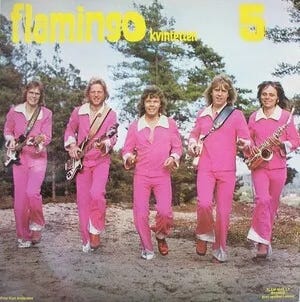Genre of the Day - Dansbandsmusik
Album of the Day - I Frödingland by Sven-Ingvars (1971)
June 9, 2024
Mouthwatering meatballs. Tart lingonberry soda. A dose of green beans, to be healthy. Satiated and full of glee, you traipse through rows of cozy yet sleek model rooms, giggling at the furniture’s names. I didn’t specify a place, but you already know that I’m talking about the glory of Ikea. To turn a furniture store into something of an industrial Disneyland is a uniquely Scandinavian feat. I understand if you object to my conjuring of Ikea as a lede for a Swedish music genre; I argue that while cliché, it holds up because today’s genre is, like Ikea, is a testament to a simple and crowd-pleasing yet thoughtful, razor-sharp Swedish approach to craft. As much as you might have experienced it buying furniture, you get a musical taste of it today.
Sweden’s place in the international pop pantheon is firmly cemented: everybody knows ABBA, and everyone has had at least one Max Martin composition slink through their mind for days on end. Perhaps a Tove Lo or Robyn song inspired the same excitement in you as it did for Megan Thee Stallion in this video.
Nearly ten years after its release, Zara Larsson’s interminable summer earworm “Lush Life” popped into my head in the shower today. With all that head-bopping, you might be shaking an important question out of your mind: how did this happen? When did Sweden fine-tune the art of pop tunes so timeless they’re practically encased in sonic amber?
The answer lies in dansbandsmusik. Unlike Swedish road signs that might appall Americans by reading “slüt”, which innocuously translates to stop, dansbandsmusik is about as easy a cognate as you’ll find—“dance band music.” Jazz and big band tunes began to decline as the choice music of the Nordic youth, displaced by the international pop-rock explosion of the 1960s. Swedish bands began to craft catchy, simple melodies that drew both upon the wide sonic possibilities of bands like the Beatles while bringing them down to danceable ground with the light sentimentality of German schlager and American countrypolitan. Though Scandinavia is infamous for high tax rates crucial to its strong social service states, Sweden’s tax laws must be a jungle, because at least during dansbundsmusik’s 1970s peak elaborate performance costumes counted as a tax write-off. Armed with these fits, dansbandsmusik became the soundtrack of Silly Swedish Summer, getting people to dance out in the fields, forests and on boats, often in pairs.
The band “Flamingokvintetten” prepares for the summer of Barbie fifty years early.
Don’t mistake the zany outfits as reflecting an unserious approach to songcraft: the best dansbands know their way around a pop tune, as proven by the group Sven-Ingvars today. They open this album with a lush bang, “Det var dans bort I vägen” [“Dancing away in the road”] dripping and gleaming with its robust string section, hammy horns, and soft rock shuffle. “Tre käringer I en backe” [“Three old woman on a hill” if my translation offers any clarity] sees them dipping into jazz territory and refusing to limit themselves genre-wise even while aiming to please crowds, just like the unexpectedly blazing guitar of “Gå på dompen,” [“Go to the dock”]. They manage to make each track distinctive while ensnaring the listener with hooks galore. Countrypolitan-pastel “En litten låt ôm vårn” and “Tre trallande jäntor”, which nods towards the hambo of olden Swedish days, offer two more slices of nation and era-spanning pop mastery. Their light gleams brightest on the Baroque revival-influenced “Anita” and the jangly joy of “Indianer”, but the whole set is a glimpse of pop globalization taken by the reins and done right. There’s still people that pop out to dansbandsmusik nostalgia-fests to this day, and I can’t say I won’t be running to join them if I touch down in Sweden.





